Phantom Pharewell
Rick Davis

As the old cliche goes; "It ain't over till the fat lady sings!" Well, the encore has ended, the stage is now empty, and singer Hilda Bovine is retired.
When DAFE first posted the rumor that Phantom Theater would be removed and be replaced by a Sally, Corp. interactive Scooby-Doo darkride over a year before, we didn't expect it to be removed from operation mid-season with virtually no notice. That is exactly what occurred. DAFE got a heads-up about it mere days before it closed. At that time PKI officially confirmed that the rumor was true, they would re-theme Phantom as Scooby-Doo and the Haunted Castle for 2003. Sadly, they chose to close the attraction before the end of the season, giving enthusiasts little chance to ride it one last time.
A pleasant surprise came to DAFE's inbox shortly thereafter: The first 20 people to reply to the email would be able to tour Phantom behind the scenes before construction began on the new ride. As far as we know, other than Cathy Baker and Rick Davis being granted a quick walkthrough of the ride to do an article for DAFE, this is the only time the public has been allowed to tour the ride. Just as with its closing, the invitation was given with only a few days notice. Needless to say, a quick reply was sent to ensure that we would get one last opportunity to document the ride.
On the appointed day we gathered at the "ACE brick", just inside the entrance to the park. (For those of you that don't know, members of ACE get a discounted admission to PKI and are escorted on a "walk-back" to either The Beast or Tomb Raider for the first ride of the day. The ACE "brick" is the gathering point.) Interestingly, all of the folks that were going to tour Phantom were ACE members. Only three in the group were also members of DAFE.
At 6:30 PM, PKI representatives, Jeff Siebert and David Mandt, met with the group to take us to the darkride. The ragtag group of enthusiasts was off to pay homage to the Phantom.
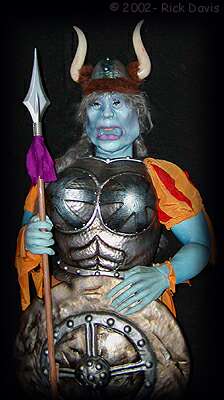 Much as paying respects to a lost friend, the group was hushed as we were ushered in through the exit door and into the loading area. Once inside we were allowed to photograph almost anything that we wanted to. Following some instructions and warnings, we were led to the former entrance lobby, which was, of course, stripped of most of its props and decorations; only the Phantom remained in his lofty perch leering down upon us one last time.
Much as paying respects to a lost friend, the group was hushed as we were ushered in through the exit door and into the loading area. Once inside we were allowed to photograph almost anything that we wanted to. Following some instructions and warnings, we were led to the former entrance lobby, which was, of course, stripped of most of its props and decorations; only the Phantom remained in his lofty perch leering down upon us one last time.
We were introduced to the man responsible for the animation maintenance, and were allowed to photograph the former queue area.  After several minutes we returned to the loading area and learned a bit about plans for the new ride. We were told that the ride system itself would remain with a few changes. The existing cars would be modified for a new look and equipped for interactive operation. In the new Scooby-Doo ride, every other ride car will be removed. Interestingly, they claim that this will NOT reduce capacity by 50%, as you would think. Perhaps they plan to speed the ride up a bit. The speed of the ride is variable and apparently was sometimes sped up on busy days. During the final days of the ride, they had increased the speed and were using every other car as a test for the upcoming changes.
After several minutes we returned to the loading area and learned a bit about plans for the new ride. We were told that the ride system itself would remain with a few changes. The existing cars would be modified for a new look and equipped for interactive operation. In the new Scooby-Doo ride, every other ride car will be removed. Interestingly, they claim that this will NOT reduce capacity by 50%, as you would think. Perhaps they plan to speed the ride up a bit. The speed of the ride is variable and apparently was sometimes sped up on busy days. During the final days of the ride, they had increased the speed and were using every other car as a test for the upcoming changes.
Soon it was time to enter the ride scenes themselves. (The ride consisted of four scenes operationally). Once inside it was obvious that there would not be much to photograph; almost all of the gags, mechanisms, and props had already been removed.
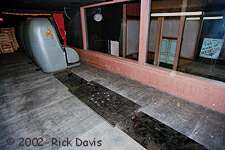

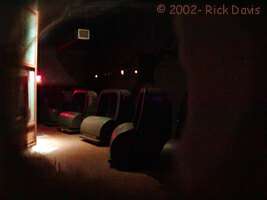
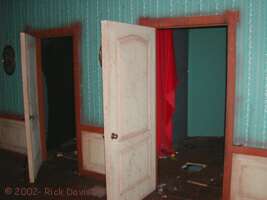
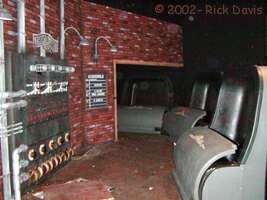
 Little remained to be seen in the first scene where the Phantom once greeted us at the beginning of the ride; we now found only an empty platform. Every step further into the scene brought only emptiness; gone were the portraits that once hung at the entrance. The usher no longer appeared to direct us on our way; the mirror that once reflected his image to make him appear to hover before our eyes only reflected the ghostly image of empty ride vehicles. Characters no longer occupied the dressing rooms, they had moved on as if finally acknowledging that Vaudeville was dead. It seems that after ten years, even the Mighty Bosco at long last managed to get his dressing room door open!
Little remained to be seen in the first scene where the Phantom once greeted us at the beginning of the ride; we now found only an empty platform. Every step further into the scene brought only emptiness; gone were the portraits that once hung at the entrance. The usher no longer appeared to direct us on our way; the mirror that once reflected his image to make him appear to hover before our eyes only reflected the ghostly image of empty ride vehicles. Characters no longer occupied the dressing rooms, they had moved on as if finally acknowledging that Vaudeville was dead. It seems that after ten years, even the Mighty Bosco at long last managed to get his dressing room door open!
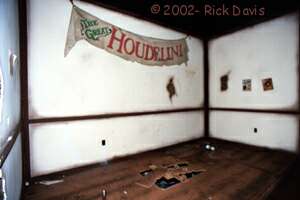 No longer was the stagehand standing by to warn us to be careful while we were backstage, nor would we see his coworker tangled and hanging from the curtain ropes. As we continued on, we also noticed that Great Houdelini was no longer on stage pulling a rabbit out of his hat, nor was famed opera singer Hilda Bovine cracking her mirror with those high notes. All we could ask ourselves was, "Where could they have gone in such a hurry?"
No longer was the stagehand standing by to warn us to be careful while we were backstage, nor would we see his coworker tangled and hanging from the curtain ropes. As we continued on, we also noticed that Great Houdelini was no longer on stage pulling a rabbit out of his hat, nor was famed opera singer Hilda Bovine cracking her mirror with those high notes. All we could ask ourselves was, "Where could they have gone in such a hurry?"
We would soon find out; the first group of our long lost friends was being stored just at the end of the second scene as if gathering one last time to say goodbye to one another and to us.
 At this point we took a little detour and left the ride area itself. We were escorted into a large shop area that the public had never seen. Inside this area was a large garage door that was open allowing access to the ride. With the door open and a movable section of the floor rolled away, we were treated to an excellent "cut away" view of the ride. The Usher (one of the few gags that remained in place) stood in front of the background scenery with props still in place. Between him and us, the cars were riding on the attraction's "floor" which at this point was about 4 feet off the "real" floor. Visible below the ride "floor" was the ride track itself. The track was tubular steel track very much like coaster track.
At this point we took a little detour and left the ride area itself. We were escorted into a large shop area that the public had never seen. Inside this area was a large garage door that was open allowing access to the ride. With the door open and a movable section of the floor rolled away, we were treated to an excellent "cut away" view of the ride. The Usher (one of the few gags that remained in place) stood in front of the background scenery with props still in place. Between him and us, the cars were riding on the attraction's "floor" which at this point was about 4 feet off the "real" floor. Visible below the ride "floor" was the ride track itself. The track was tubular steel track very much like coaster track.
The cars themselves were attached to a carriage below the ride floor via a shaft. Each carriage had running wheels riding the top of the track with side friction wheels inside the track. The main difference between this arrangement and a coaster's is the lack of up-stop wheels. Below the running rails was another rail; the rail that controlled the orientation of the car. While the roller coaster "X" uses a similar idea to control its cars orientation, note that Phantom Theater used a similar idea more than ten years before!
 The three-wheel truck (two wheels outside, one inside the rail) that followed the lower control rail was attached to an arm that had a gear on its other end. A chain connected to that gear was in turn connected to a gear attached to the center pivot of the car.
The three-wheel truck (two wheels outside, one inside the rail) that followed the lower control rail was attached to an arm that had a gear on its other end. A chain connected to that gear was in turn connected to a gear attached to the center pivot of the car. 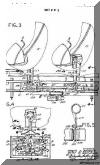 To turn the car, the position of the rail would move in or out, thus turning the car. The patent shown here depicts Disney's "doom buggy" ride system. While not exactly the same as this ride system, it is assumed that Phantom's ride system is a direct descendant of the "doom buggy". (Click the image to see a larger drawing)
To turn the car, the position of the rail would move in or out, thus turning the car. The patent shown here depicts Disney's "doom buggy" ride system. While not exactly the same as this ride system, it is assumed that Phantom's ride system is a direct descendant of the "doom buggy". (Click the image to see a larger drawing)
It is interesting to note that the park has chosen to change the car orientation in the ride and the scenery locations from the way it was in Phantom. This will require removing and repositioning the under rails along the entire ride. Note that the highest part of the track, and most accessible, is only about 4 feet high and the other areas have little room to work since the track rests on or near the floor.
As was mentioned earlier, this was an excellent cutaway view of the ride and an excellent photo opportunity that would have shown how the ride mechanism operated, but we were asked not to shoot photos in this area. Three areas were off limits for photos in the walkthrough for "proprietary reasons", unfortunately denying fans a rare glimpse of a unique operating system.
 Moving back to the operating area, we continued to walk through the ride, past the Peppers Ghost scene and to a stairway leading down to a small storage area filled with more ride figures. This also brought us to the electronics room. Again, this was off limits to photography.
Moving back to the operating area, we continued to walk through the ride, past the Peppers Ghost scene and to a stairway leading down to a small storage area filled with more ride figures. This also brought us to the electronics room. Again, this was off limits to photography.
The room mainly contained circuit breaker panels and 5 racks of "off the shelf" amplifiers and patch panels. To the left of the amplifier racks were the brains of the system. This rack contained all the digitized sounds for the entire ride as well as the public address system that was used in emergencies (and to scold us for taking photographs when the ride was in operation!) The output of the sound system of course fed the amplifier racks. The room mainly contained circuit breaker panels and 5 racks of "off the shelf" amplifiers and patch panels. To the left of the amplifier racks were the brains of the system.
This rack contained all the digitized sounds for the entire ride as well as the public address system that was used in emergencies (and to scold us for taking photographs when the ride was in operation!) The output of the sound system of course fed the amplifier racks.
Below the sound cards were the digital cards that controlled each scene, function, sound, and lighting effect in the entire ride. All of the figures and their moving parts were either digital or analog devices or a combination of the two. Basically, the digitally controlled features of the ride operated via pneumatic solenoids controlled by a 24 volt signal and were either on or off. In other works, the voltage caused something to move from point "A" to point "B" directly with no stops or speed changes in between.
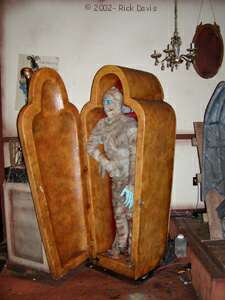 The analog controlled features of the attraction operated via pneumatic solenoids controlled by a variable voltage from zero to 10 volts. The control voltage here allowed for a variable range of motion of an arm, for example, as well as variable speed of that arm. Here the variable voltage allowed an arm to move a short distance, reverse or continue on, and to move fast or slow depending on the whims of the computer programmer.
The analog controlled features of the attraction operated via pneumatic solenoids controlled by a variable voltage from zero to 10 volts. The control voltage here allowed for a variable range of motion of an arm, for example, as well as variable speed of that arm. Here the variable voltage allowed an arm to move a short distance, reverse or continue on, and to move fast or slow depending on the whims of the computer programmer.
Leaving the electronics area, we continued the tour almost to the end of the ride. We stopped in the area of the Mummy and Gargoyle, which were still in place in their scene. Here Houdelini's magic hat appeared to perform one last feat of "magic". From the hat was drawn the name of a lucky winner that won a packet that contained some rare 1992 public relations material that included a PKI press kit, media invitation, park brochure and other Phantom related material as well as an on ride video!
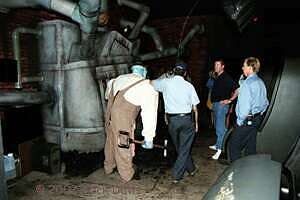 From here, it was on to the furnace room, which was still intact. Finally there was a scene in which we could look behind the scenes to see how it worked. Looking inside the "furnace" revealed that the "hot coals" that flickered and glowed were molded, colored plastic which was lit from behind with flickering light bulbs and fiber optics. Interestingly, the coal strewn about the floor in front of the furnace was real coal. Overhead was the heating duct that provided that blast of hot air directed at the car when it was in front of the furnace.
From here, it was on to the furnace room, which was still intact. Finally there was a scene in which we could look behind the scenes to see how it worked. Looking inside the "furnace" revealed that the "hot coals" that flickered and glowed were molded, colored plastic which was lit from behind with flickering light bulbs and fiber optics. Interestingly, the coal strewn about the floor in front of the furnace was real coal. Overhead was the heating duct that provided that blast of hot air directed at the car when it was in front of the furnace.
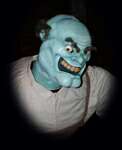
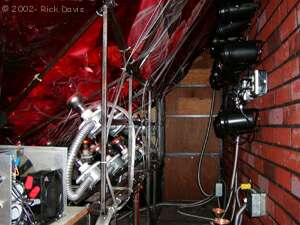

 After studying this area, we were led back in the loading area, but that was not the end of the tour. Directly behind the loading area was a small maintenance shop area which was off limits to photography. Going through this room we discovered that we were behind the glass of the Pepper's Ghost theater scene. This would have been an excellent opportunity to photograph the scene to demonstrate how the illusion is accomplished, but the figures had all been removed. A few interesting facts emerged. There were two sets of glass: One was directly in front of the rider, and the second was what the images actually reflect from. While the glass directly in front of the ride vehicles was often covered with the finger prints of riders, the interior glass that was responsible for the illusion itself was spotless. The interior glass panes were huge and had to be specially ordered: a spare glass pane resided behind the rear curtain of the stage scene. This was a necessity since there was no way to bring in a new pane should it have been needed. The story goes that the glass was originally lowered through a hole in the roof!
After studying this area, we were led back in the loading area, but that was not the end of the tour. Directly behind the loading area was a small maintenance shop area which was off limits to photography. Going through this room we discovered that we were behind the glass of the Pepper's Ghost theater scene. This would have been an excellent opportunity to photograph the scene to demonstrate how the illusion is accomplished, but the figures had all been removed. A few interesting facts emerged. There were two sets of glass: One was directly in front of the rider, and the second was what the images actually reflect from. While the glass directly in front of the ride vehicles was often covered with the finger prints of riders, the interior glass that was responsible for the illusion itself was spotless. The interior glass panes were huge and had to be specially ordered: a spare glass pane resided behind the rear curtain of the stage scene. This was a necessity since there was no way to bring in a new pane should it have been needed. The story goes that the glass was originally lowered through a hole in the roof!

 As you know, the Pepper's Ghost illusion works by reflecting (hidden) brightly lit objects off the surface of the glass causing a ghostly image to appear in a scene. In Phantom, the "audience" and the "actors" were located above and behind the ride vehicles as well as below and in front of them, out of view.
As you know, the Pepper's Ghost illusion works by reflecting (hidden) brightly lit objects off the surface of the glass causing a ghostly image to appear in a scene. In Phantom, the "audience" and the "actors" were located above and behind the ride vehicles as well as below and in front of them, out of view.
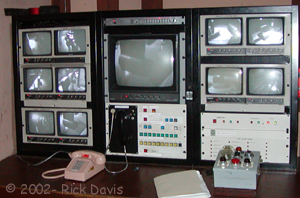
While the legend of the Phantom Theater has come to an end, this is not the end of the darkride legacy that began in 1972. Sally Corporation will be converting the building into the interactive Scooby-Doo and the Haunted Castle darkride for the 2003 season. Watch the Daffy Klub web site for future news, photos, and stories about the new attraction.
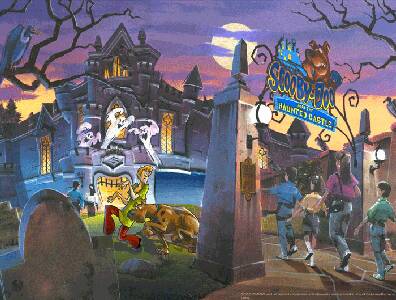
According to Jeff Seibert, the new Scooby Doo ride will be "A heavily themed, totally immersive, interactive D A R K R I D E A D V E N T U R E !
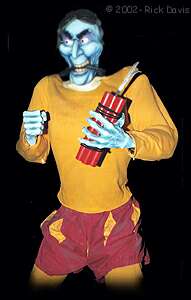
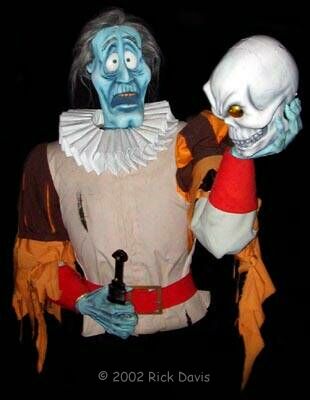
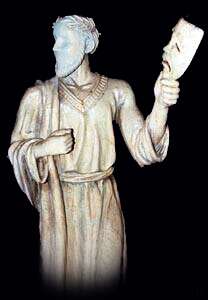

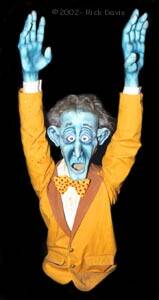
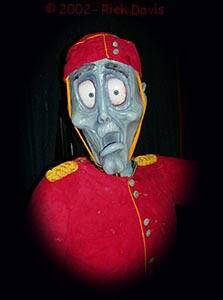
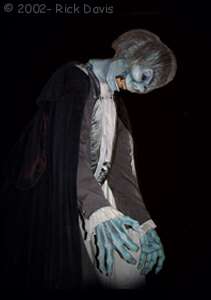
Goodbye friends, thanks for the memories.

